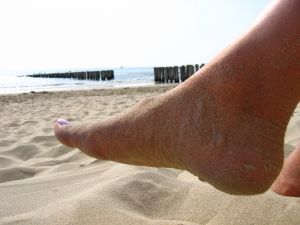Jana, 38, was so enthralled with learning to play tennis that she began booking a court seven days a week. After a particularly rewarding set, she took a shower, then got dressed to meet her husband for lunch. As she pulled on her right shoe, pain shot up her leg. It took nearly a month and a lot of missed court dates before she found out she was suffering from retrocalcaneal bursitis.
Definition
Bursitis is an inflammation of a fluid-filled sac known as a bursa. These sacs function like cushions and lubricants between muscles and tendons that slide over bone. They’re located around most large joints of the body, according to MedlinePlus.
Retrocalcaneal bursitis is swelling of the bursa at the back of the heel bone (calcaneus), where the large Achilles tendon connects this bone to the calf muscles. The University of Maryland Medical Center indicates that this condition is also called insertional heel pain.
Causes
The most common reason why this type of bursitis develops is repeated or excessive use of the ankle, such as too much walking, running or jumping. This overuse can cause the bursa to become irritated, then inflamed.
Retrocalcaneal bursitis is often associated with Achilles tendinitis and can be mistaken for that condition. Individuals just beginning ambitious exercise regimens or who increase their activity level suddenly or without proper conditioning are at an elevated risk level for developing this type of inflammation.
Symptoms
Patients with retrocalcaneal bursitis experience pain in the heel during walking or running. Anything touching the affected area can be particularly painful. When these individuals stand on their tiptoes, the pain often worsens. The skin over the back of the heel is typically red and warm to the touch.
Although complications are rate, tendon rupture can occur when bursitis is associated with tendinitis or after the use of too-frequent steroid injections.
Diagnosis and Treatment
A health care provider will initially take a history to identify any symptoms common to this kind of bursitis. The physical exam includes taking a good look at the ankle of the affected leg to determine the site of the pain. It also involves examining the back of the heel for redness and tenderness.
Many patients react when the doctor bends the ankle upward or when they’re asked to rise on their toes. Sometimes physicians will also order imaging studies like X-rays or MRI scans.
Once the health care provider has diagnosed retrocalcaneal bursitis, he or she will recommend one or more standard treatments. These include steering clear of activities that result in pain, icing the heel several times per day, and taking nonsteroidal anti-inflammatory drugs (NSAIDs) like ibuprofen.
Other traditional treatments include using wedges to minimize stress on the heel, undergoing physical therapy for increased flexibility and strength, and injecting small quantities of steroids into the bursa. If the patient also has Achilles tendinitis, a cast might be necessary for a few weeks. Surgery to remove the inflamed bursa is rare.
Most individuals improve over the course of several weeks when they receive adequate treatment. Appropriate conditioning, proper form while exercising, and maintaining strength and flexibility in the ankle area are all important in preventing retrocalcaneal bursitis.
Sources:
MedlinePlus site
The University of Maryland Medical Center site
Reference:
- MedlinePlus site
- The University of Maryland Medical Center site
